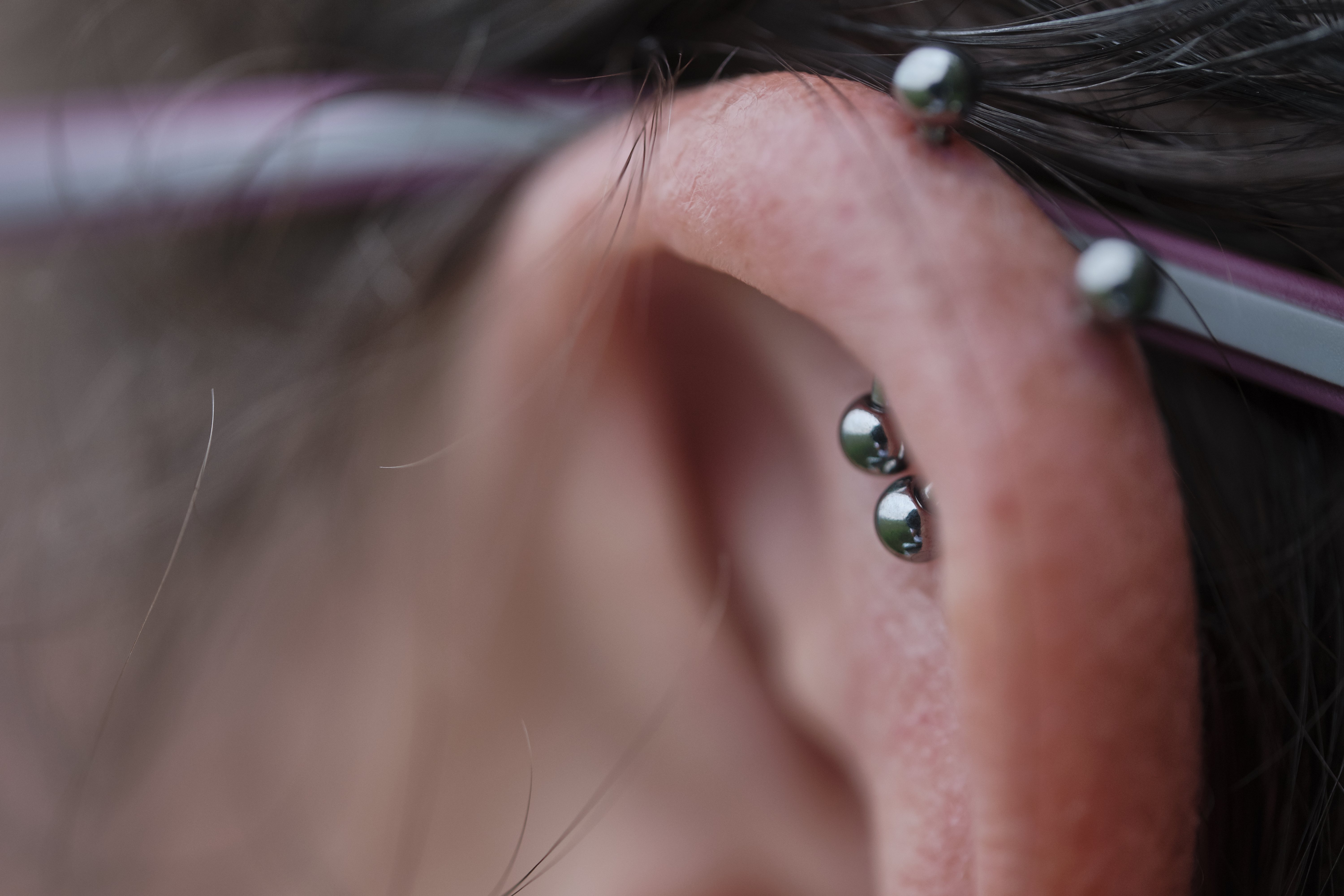
Facts about the Double Helix Piercing - Procedure & Aftercare
The double helix piercing has origins dating decades back. Younger generations, including celebrities, have been rocking this body modification as it has become more socially accepted.
The helix piercing took center stage in the 1990s, and as body modification gradually became more socially accepted in the past decade, it's becoming more mainstream. As celebrities such as Miley Cyrus and Lucy Halle rock the helix piercing, its media popularity has skyrocketed.
The helix piercing typically pairs well with one or two lobe piercings already in place. It can be done by people of any gender identity, though it used to be more popular among women.
While it falls under cartilage piercings, the helix only covers a tiny fraction of the cartilage. Other cartilage piercings, which have their own variations, include the tragus (variations include the surface tragus and the anti-tragus), rook, conch, and daith piercings.
The helix piercing also has variations, including a forward, backward, double, or triple helix. With the double helix piercing, as is the focus of this article, it's imperative to be aware of how to prepare for it, what to expect, and how to care for it properly while it heals.
There Are Two Types of a Double Helix Piercing
The double helix piercing refers to the number of piercings you have (2) or plan to get done. Its two types are the standard and the forward double helix, both of which refer to the placement relative to the ear's anatomy.
A double helix's standard placement is located toward the rear part of the ear, found by running a finger from the lobe along the curve of the cartilage to the tip. The double forward helix is slightly beyond the tip of the cartilage, as it is located across the double helix facing the front. It sits directly above the tragus.

A close-up of a woman with a double helix piercing | Source: Getty Images
What You Need to Know before Double Helix Piercing
Experts and those who've done a double helix piercing rated the pain, on a scale of 1-10, between 4 and 7. However, while it is generally accepted that a double helix's pain level is medium on that spectrum, one's pain tolerance is still a determining factor.
The general healing period for a double helix is between three-to-six months, but it may take up to a year to fully heal. Therefore, proper aftercare is essential to avoid an unnecessarily elongated healing period, re-piercing, and infections.
Researching which body modification studio to visit and the experience of the studio's piercers can help avoid those unfavorable consequences. Sleeping on or swimming with a new double helix is also advised against until after it is fully healed.
Cost is another factor to consider; double helix piercings can range between $30 to $75, depending on the studio's location. And while going for a double helix piercing as one's first piercing is acceptable, lobe piercings are recommended as that area is the least painful to push a needle through.
New piercings are typically done with stud earrings instead of rings, as these are the safest options for piercing. Rings are advised against, as they are more likely to twist and move around the freshly pierced site, which is unideal for the healing process.
Your Path to Double Helix Piercing
The first step is to find a creditable piercing parlor with a trustworthy team of experienced piercers. If the double helix is the first ear piercing one acquires, it would be wise to schedule a consultation with a professional that has experience with cartilage piercings to get as much information as possible.
The following step is to ensure that the piercing equipment used is new and that the procedure is done in a clean and sterile environment. That includes double-checking if the piercer uses multiple gloves throughout and a needle to penetrate the cartilage, not a piercing gun.
Piercing guns are advised against as parts of the gadgets cannot be sterilized. They can also cause trauma and infection. During the last step of preparation, the piercer will mark the piercing site with a dot and show their client so they are satisfied before proceeding.

A piercer is pictured marking a client's ear with ink in preparation for a piercing | Source: Getty Images
How Do I Choose Jewelry for Double Helix Piercing?
Experts have recommended going for jewelry made of 14k gold or implant-grade titanium, as those materials are the safest and are of the highest quality. 14k gold, for example, is the least likely to cause allergic reactions, unlike cheaper metals such as nickel.
Choosing the right size to allow for proper healing is also recommended, and an experienced piercer can advise. The standard size is 16 gauge and 18 gauge, while the lengths vary between 3/16", 1/4", 5/16", and 4/8".
As previously mentioned, studs are better for new double helix piercings than hoops or rings. One can switch to hoops once the piercing has healed and even lower-grade metal jewelry if one is not prone to allergic reactions.
Moreover, one can start experimenting with different double helix piercing jewelry styles, including captive bead rings, which can have elaborate or simple bead designs and help keep the jewelry in place. One can also try seam rings or labret studs.
Care for a Double Helix Piercing
After the piercing procedure, the piercer will provide aftercare instructions, and in some studios, aftercare products, as covered by the fee. The client may experience some irritation afterward; however, this reaction can be confused with an infection.
Irritation symptoms typically last a few weeks. They include slight bleeding, yellow crust around the pierced site (dead skin cells), tenderness, swelling, bruising, and soreness, but any symptoms beyond that require the attention of a medical professional.
Regarding the change of jewelry, experts recommend a follow-up appointment with the piercer three-to-six months after the first so they can change it for the client. That way, the client can watch and learn how to change it themselves.
Side Effects of Double Helix Piercing
Apart from infection, some side effects of acquiring a double helix piercing include scarring and keloids, which are raised scars resulting from an overgrowth of scar tissue. The body may also reject a piercing, in which case, a doctor's visit is advised.
Regarding spotting an infection, the signs to look out for include severe swelling and redness, tenderness, pus or smelly discharge oozing from the pierced site, and fever. Professionals recommend cleaning the piercing twice daily and avoiding touching or moving it while it heals.
The information in this article is not intended or implied to be a substitute for professional medical advice, diagnosis or treatment. All content, including text, and images contained on WomanlyLive.com, or available through WomanlyLive.com is for general information purposes only. WomanlyLive.com does not take responsibility for any action taken as a result of reading this article. Before undertaking any course of treatment please consult with your healthcare provider.
